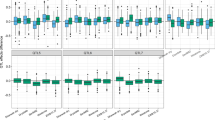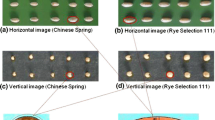Abstract
A major aim in some plant-based studies is the determination of quantitative trait loci (QTL) for multiple traits or across multiple environments. Understanding these QTL by trait or QTL by environment interactions can be of great value to the plant breeder. A whole genome approach for the analysis of QTL is presented for such multivariate applications. The approach is an extension of whole genome average interval mapping in which all intervals on a linkage map are included in the analysis simultaneously. A random effects working model is proposed for the multivariate (trait or environment) QTL effects for each interval, with a variance–covariance matrix linking the variates in a particular interval. The significance of the variance–covariance matrix for the QTL effects is tested and if significant, an outlier detection technique is used to select a putative QTL. This QTL by variate interaction is transferred to the fixed effects. The process is repeated until the variance–covariance matrix for QTL random effects is not significant; at this point all putative QTL have been selected. Unlinked markers can also be included in the analysis. A simulation study was conducted to examine the performance of the approach and demonstrated the multivariate approach results in increased power for detecting QTL in comparison to univariate methods. The approach is illustrated for data arising from experiments involving two doubled haploid populations. The first involves analysis of two wheat traits, α-amylase activity and height, while the second is concerned with a multi-environment trial for extensibility of flour dough. The method provides an approach for multi-trait and multi-environment QTL analysis in the presence of non-genetic sources of variation.


Similar content being viewed by others
References
Beavis WD (1994) The power and deceit of QTL experiments: lessons from comparative QTL studies. In: Proceedings of the forty-ninth annual corn and sorghum industry research conference. American Seed Trade Association, Washington, DC, pp 250–266
Beavis WD (1998) QTL analyses: power, precision and accuracy. In: Patterson AH (ed) Molecular dissection of complex traits. CRC Press, New York, pp 145–162
Boer MP, Wright D, Feng L, Podlich DW, Luo L, Cooper M, van Eeuwijk FA (2007) A mixed-model quantitative trait loci (QTL) analysis for multiple-environment trial data using environmental covariables for QTL-by-environment interactions, with an example in maize. Genetics 177:1801–1813
Broman KW, Wu H, Churchill G, Sen S, Yandell B (2009) qtl: Tools for analyzing QTL experiments. http://www.biostat.jhsph.edu/kbroman/qtl (r package version 1.11-12)
Butler DB, Tan MK, Cullis BR (2009) Improving the accuracy of selection for late maturity α-amylase in wheat using multi-phase designs. Crop Pasture Sci 60:1202–1208
Butler DG, Cullis BR, Gilmour AR, Gogel BJ (2007) ASReml-R, reference manual. Technical report, Queensland Department of Primary Industries
Gelman A, Carlin JB, Stern HS, Rubin DB (2004) Bayesian data analysis, 2nd edn. Chapman and Hall/CRC
Gilbert H, Le Roy P (2003) Comparison of three multitrait methods for QTL detection. Genet Select Evol 35:281–304
Golub G, van Loan C (1996) Matrix computations, 3rd edn. The Johns Hopkins University Press, London
Gonzalo M, Vyn TJ, Holland JB, McIntyre LM (2006) Mapping density response in maize: a direct approach for testing genotype and treatment interactions. Genetics 173:331–348
Hackett CA, Meyer RC, Thomas WTB (2001) Multi-trait QTL mapping in barley using multivariate regression. Genet Res 77:95–106
Haley CS, Knott SA (1992) A simple regression method for mapping quantitative trait loci in line crosses using flanking markers. Heredity 69:315–324
Jansen RC (1994) Controlling the type I and type II errors in mapping quantitative trait loci. Genetics 138:871–881
Jiang C, Zeng ZB (1995) Multiple trait analysis of genetic mapping for quantitative trait loci. Genetics 140:1111–1127
Kenward MJ, Roger JH (1997) Small sample inference for fixed effects from restricted maximum likelihood. Biometrics 53:983–997
Knott SA, Haley CS (2000) Multitrait least squares for quantitative trait loci detection. Genetics 156:899–911
Korol A, Ronin Y, Kirzhner V (1995) Interval mapping of quantitative trait loci employing correlated trait complexes. Genetics 140:1137–1147
Korol AB, Ronin YI, Nevo E, hayes PM (1998) Multi-interval mapping of correlated trait complexes. Heredity 80:273–284
Lund M, Sorensen P, Guldbrandtsen B, Sorensen D (2003) Multitrait fine mapping of quantitative trait loci using combined linkage disequilibria and linkage analysis. Genetics 163:405–410
Malosetti M, Ribaut JM, Vargas M, Crossa J, van Eeuwijk FA (2008) A multi-trait multi-environment QTL mixed model with an application to drought and nitrogen stress trials in maize (Zea mays l.). Euphytica 161:241–257
Manly KF, Cudmore RH, Meer JM (2001) Map manager QTX, cross-platform software for genetic mapping. Mammal Genome 12:930–932
Mann G, Diffey S, Cullis BR, Azanza F, Martin D, Kelly A, McIntyre L, Schmidt A, Ma W, Nath A, Kutty I, Leyne PE, Rampling L, Quail KJ, Morell MK (2008) Genetic control of wheat quality: interactions between chromosomal regions determining protein content and composition, dough rheology, and sponge and dough baking properties. Theor Appl Genet 118:1519–1537
Martinez O, Curnow RN (1992) Estimating the locations and the sizes of the effects of quantitative trait loci using flanking markers. Theor Appl Genet 85:480–488
Melchinger AE, Utz HF, Schon CC (1998) Quantitative trait loci (QTL) mapping using different testers and independent population samples in maize reveals low power of QTL detection and large bias in estimates of QTL effects. Genetics 149:383–403
Mrva K, Mares DJ (1996) Expression of late maturity α-amylase in wheat containing gibberellc acid insensitivity genes. Euphytica 88:69–76
Patterson HD, Thompson R (1971) Recovery of interblock information when block sizes are unequal. Biometrika 58:545–554
Piepho HP (2000) A mixed-model approach to mapping quantitative trait loci in barley on the basis of multiple environment data. Genetics 156:2043–2050
R Development Core Team (2009) R: a language and environment for statistical computing. R Foundation for Statistical Computing, Vienna. http://www.R-project.org, ISBN 3-900051-07-0
Robinson GK (1991) That BLUP is a good thing: the estimation of random effects. Stat Sci 6:15–51
Smith AB, Cullis BR, Thompson R (2001) Analyzing variety by environment data using multiplicative mixed models and adjustments for spatial field trend. Biometrics 57:1138–1147
Smith A, Cullis B, Thompson R (2005) The analysis of crop cultivar breeding and evaluation trials: an overview of current mixed model approaches. J Agric Sci (Cambr) 143:449–462
Smith AB, Lim P, Cullis BR (2006) The design and analysis of multi-phase quality trait experiments. J Agric Sci (Cambr) 144:393–409
Sorensen P, Lund M, Guldbrandtsen B, Jensen J, Sorensen D (2003) A comparison of bivariate and univariate QTL mapping in livestock populations. Genet Select Evol 35:605–622
Stranden I, Garrick DJ (2009) Derivation of equivalent computing algorithms for genomic predictions and reliabilities of animal merit. J Dairy Sci 92:2971–2975
Tan MK, Verbyla AP, Cullis BR, Martin P, Milgate AW, Oliver JR (2010) Genetics of late maturity α -amylase in a doubled haploid wheat population. Crop Pasture Sci 61:153–161
Taylor JD, Diffey S, Verbyla AP, Cullis BR (2009) wgaim: whole genome average interval mapping for QTL detection using mixed models. R package version 0.02-1
Tinker NA, Mather DE (1995) Methods for QTL analysis with progeny replicated in multiple environments. J Quant Trait Loci 1. http://probe.nalusda.gov:8000/otherdocs/jqtl/index.html
van Eeuwijk FA, Bink MCAM, Chenu K, Chapman SC (2010) Detection and use of QTL for complex traits in multiple environments. Curr Opin Plant Biol 13:193–205
Vargas M, van Eeuwijk FA, Crossa J, Ribaut JM (2006) Mapping QTLs and QTL × environment interaction for CYMMYT maize drought stress program using factorial regression and partial least squares methods. Theor Appl Genet 112:1009–1023
Verbyla AP, Talor JD (2012) High-dimensional whole genome average interval mapping and a random effects formulation. Theor Appl Genet (in preparation)
Verbyla AP, Eckermann PJ, Thompson R, Cullis BR (2003) The analysis of quantitative trait loci in multi-environment trials using a multiplicative mixed model. Aust J Agric Res 54:1395–1408
Verbyla AP, Cullis BR, Thompson R (2007) The analysis of QTL by simultaneous use of the full linkage map. Theor Appl Genet 116:95–111
Wang DL, Zhu J, Li ZK, Paterson AH (1999) Mapping QTLs with epistatic effects and QTL × environment interactions by mixed linear model approaches. Theor Appl Genet 99:1255–1264
Whittaker JC, Thompson R, Visscher PM (1996) On the mapping of QTL by regression of phenotype on marker-type. Heredity 77:23–32
Xu S (2003) Theoretical basis of the Beavis effect. Genetics 165:2259–2268
Zeng ZB (1994) Precision mapping of quantitative trait loci. Genetics 136:1457–1468
Zeng ZB, Kao CH, Basten CJ (1999) Estimating the genetic architecture of quantitative traits. Genet Res 74:279–289
Acknowledgments
The authors gratefully acknowledge the financial support of the Grains Research and Development Corporation (GRDC) through the Statistics for the Australian Grains Industry (SAGI) project.
Author information
Authors and Affiliations
Corresponding author
Additional information
Communicated by C. Schön.
Electronic supplementary material
Below is the link to the electronic supplementary material.
Appendix: The score statistic under the alternative outlier model
Appendix: The score statistic under the alternative outlier model
The full (marginal) model for \({\mathbf y}\) under the AOM (9) can be written as
where if \({\mathbf M}_{E,k} = {\mathbf M}_E {\mathbf D}_k,\) the selected columns of \({\mathbf M}_E\) corresponding to the kth chromosome, the variance matrix \({\mathbf H}\) is given by
As in Verbyla et al. (2007), an outlier statistic is developed using the score for σ 2 ak under the null hypothesis \(H_0:\; \sigma_{ak}^2 = 0.\) If \({\mathbf P} = {\mathbf H}^{-1} - {\mathbf H}^{-1}{\mathbf X} ({\mathbf X}^T{\mathbf H}^{-1}{\mathbf X})^{-1}{\mathbf X}^T{\mathbf H}^{-1},\) the REML score for σ 2 ak evaluated at zero is
Let \({\mathbf a}_k\) be the vector of sizes for all variates for all intervals on chromosome k, with individual intervals having sizes given by \({\mathbf a}_{kl}.\) Then the BLUP for \({\mathbf a}_k\) is
with variance
It may be that \({\mathbf G}_a\) is non-negative definite, rather than positive definite. Thus \({\mathbf G}_a\) may be singular. If \({\mathbf G}_a^-\) is a generalized inverse of \({\mathbf G}_a,\) \({\mathbf G}_a\) can be replaced in (19) by \({\mathbf G}_a{\mathbf G}_a^-{\mathbf G}_a,\) and hence using (20), (21) and properties of the trace, (19) can be written as
where t 2 k is given by (10). Thus t 2 k indicates the departure from U k (0) = 0. This statistic therefore provides evidence that σ 2 ak departs from zero for chromosome k. The chromosome most likely to contain a QTL is the one with largest t 2 k .
The statistic t 2 k is made up of components that relate to the intervals on chromosome k. Hence using a similar argument, the outlier statistics for individual intervals is given by t 2 kl in (11).
A fully parameterized \({\mathbf G}_a\) requires many parameters for larger multivariate problems and an approximation becomes both sensible and necessary. It is possible to use a factor analytic approximation for the full covariance model \({\mathbf G}_a\) which mirrors the use of FA models in the analysis of multi-environment trials.
Rights and permissions
About this article
Cite this article
Verbyla, A.P., Cullis, B.R. Multivariate whole genome average interval mapping: QTL analysis for multiple traits and/or environments. Theor Appl Genet 125, 933–953 (2012). https://doi.org/10.1007/s00122-012-1884-9
Received:
Accepted:
Published:
Issue Date:
DOI: https://doi.org/10.1007/s00122-012-1884-9




